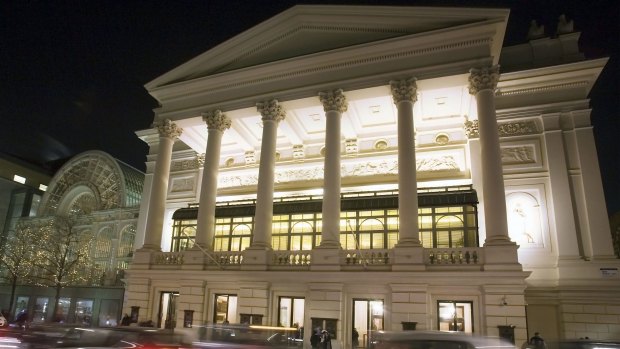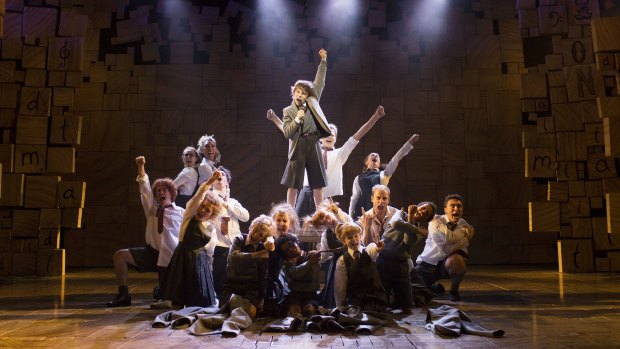By Patti Nickell

The Royal Opera House in Covent Garden looks spectacular lit up at night.Credit: Stephen McLaren
"All the world's a stage," William Shakespeare penned in his comedy, As You Like It. In this, the 400th anniversary of the Bard's death, if all the world isn't a stage, a good part of London certainly is.
From the black-and-white Elizabethan splendour of Shakespeare's reconstructed Globe Theatre to the historic Rose Theatre, to the acclaimed National Theatre, which once counted Sir Laurence Olivier as its artistic director, London's theatre scene is arguably the world's most vibrant.
It all began in 1587 with the establishment of The Rose on the South Bank of the Thames, an area rife with gambling dens, brothels, and low-brow forms of entertainment such as bear and bull baiting. The Rose raised the bar, becoming Shakespeare's first home until he and his company moved to the nearby Globe.

The Royal Shakespeare Company's production of "Matilda The Musical" is on at the Cambridge Theatre in Seven Dials.Credit: Helen Maybanks
It took another 376 years before the dominant South Bank playhouse, The National Theatre, opened further west. Described by Prince Charles architecturally as "a nuclear power plant on the Thames", the National has nonetheless become one of the world's most influential theatres, offering 30 productions a year, from Greek and Shakespearean tragedies to modern classics and contemporary works.
Visitors can enjoy not only the dramatic offerings, but a brush with theatrical history during backstage tours at each of the three venues.
COVENT GARDEN AND THE WEST END
While London's 240 theatres can be found on both banks of the Thames, the greatest concentration is grouped in the West End, in the area surrounding Covent Garden.
Get acquainted with Covent Garden on a walking tour (one of the best is with Blue Badge Guide Sophie Campbell; book her at sophieccampbell@gmail.com.) Through information gleaned on the walk, you'll learn that this area is nothing if not ... well, theatrical.
Fred Astaire and his sister Adele once danced on the roof of the Savoy Hotel as a publicity stunt, while just a few doors away, in that most British of dining emporiums, Simpson's-in-the-Strand, waiters still bring patrons chessboards if they wish to play while they dine – in homage to its former life as a chess club.
You'll see St Paul's Church, dubbed the Actors' Church, where plaques honour such luminaries as Vivien Leigh, Charlie Chaplin and Noel Coward, and where the ashes of 19th-century thespian Ellen Terry are kept in a biscuit tin.
You'll see the Garrick Club, a private members' club named after Shakespearean actor David Garrick, whose founders in 1831 wrote into the club rules that "it was better that 10 unobjectionable men be excluded than one terrible bore be admitted".
If you can't get to Covent Garden's magnificent Royal Opera House for a performance, you can hear fledging opera stars perform arias on the piazza and, if you're here on a Saturday, you can greet the Pearly Kings and Queens in their elaborate finery, studded head-to-toe with mother-of-pearl buttons.
Although Covent Garden had a peaceful beginning in the 12th century as the convent garden of Benedictine nuns, things got a bit bawdier over the centuries. It was a fruit, vegetable and flower market in the 17th century when orange seller Nell Gwynne was plucked from obscurity to become first an actress at the nearby Drury Lane Theatre and then, mistress of King Charles II.
Neither was the area a stranger to what can only be described as very theatrical murders. The Adelphi Theatre, now the venue for the dazzling musical Kinky Boots, was a 19th-century murder scene. Actor William Terriss, aka "Breezy Bill," known for swashbuckling stage roles, was stabbed to death in 1897 by a jealous colleague outside the stage door.
Another high-profile murder was committed a century earlier outside the Royal Opera House when British singer Martha Ray, mistress of the Earl of Sandwich (best known for being the first to slap a piece of meat between two slices of bread) was shot by a deranged admirer as she left a performance.
Not all stories ended tragically. One, in fact, is downright hilarious. Adelina Patti, a 19th-century Spanish bel canto soprano and then the highest-earning star in the world, came to perform at the Royal Opera House. As it was the custom at that time to wear one's own clothing rather than a costume, Patti – who would have given Madonna a run for her money in the diva department –wore a gown encrusted with 3600 diamonds.
Worried about protecting the star and her dress, Opera House staff brought in two Bow Street police officers and installed them in the male chorus to keep an eye on the diva and her dress.
The epicentre of Covent Garden and the West End is, of course, the theatres. From glitzy musicals (Matilda, based on Roald Dahl's book, at the Cambridge Theatre in Seven Dials, and Motown the Musical at the Shaftesbury) to avant-garde dramas (Jean Genet's The Maids) to gut-bustingly hilarious farces (The Play That Goes Wrong), London theatre has something for everyone.
DINING AND STAYING IN COVENT GARDEN
As befits such a dramatic part of London, Covent Garden and its environs have some pretty dramatic hotels and restaurants. At One Aldwych Hotel, depending on where your room is located, you may have a view of the marquees at the Lyceum, where The Lion King has been delighting audiences for 17 years, or the Novello, home to the equally popular Mamma Mia.
One Aldwych is within walking distance of 15 West End theatres, but the best show may be the continuous parade of smartly dressed patrons who pack the stunning first-floor Lobby Bar from mid-morning to the wee hours ... a London bar with more buzz would be hard to find. (onealdwych.com)
St. Martins Lane Hotel is a boutique gem also in the heart of the theatre district. The sleek lobby is a sophisticated reinterpretation of Philippe Starck's original design, which means lots of quirky touches.
Grasp the outstretched silver hand on a door and it opens to reveal the Blind Spot, the hotel's innovative cocktail bar. A split-level space off the lobby appears to be a library, but turns out to be Asia de Cuba restaurant, whose menu offers a feast of Latin-Asian fusion dishes. (morganshotelgroup.com)
As for other dining opportunities, you won't lack for them. If you've been to Balthazar and Joe Allen's in New York, you'll appreciate their London counterparts. Balthazar, just off Covent Garden's central piazza, is a great breakfast spot, while Joe Allen's is patronised by film, television and stage stars.
If you're looking for a good spot for a pre-theatre dinner, opt for Kopapa in Seven Dials, the Amphitheatre Restaurant at the Royal Opera House, the Ivy Market Grill on Covent Garden's piazza, and Cafe Murano, showcasing the talents of Michelin star recipient Angela Hartnett, formerly of the Connaught Hotel.
J. Sheekey also offers a pre-theatre menu, but you might want to save this one for an evening when you have plenty of time to linger. Specialising in sophisticated fish dishes, it is the epitome of elegant dining. The cold lobster with mayonnaise served with a chilled white wine is culinary heaven.
Don't be in a hurry either at Spring, an absolutely gorgeous space that occupies one wing of Somerset House on the Strand. The restaurant is aptly named; even in winter you'll feel like you're in a spring garden, with its all-white decor and huge windows. Skye Gyngell, a transplanted Australian who won a Michelin star at her popular Petersham Nurseries, brings the same magic to Spring.
No one in London was ever more theatrical than Oscar Wilde, and he found a spot as flamboyant as he was in Cafe Royal, which became a sort of clubhouse for Wilde and his cronies.
Visitors can enjoy afternoon tea in the gilded splendour of the Oscar Wilde Bar, or opt for a more modern experience with dinner in the Ten Room and drinks in the Green Bar, where signature cocktails are made from botanicals, celebrating London's history of using various botanicals in gin production.
It's a perfectly theatrical ending to a perfectly theatrical trip.
IF YOU GO
visitbritain.com; visitlondon.com
MCT
Sign up for the Traveller Deals newsletter
Get exclusive travel deals delivered straight to your inbox. Sign up now.